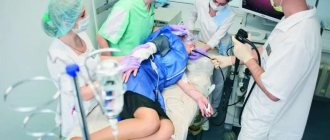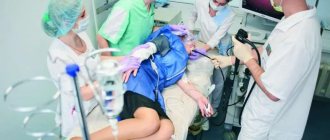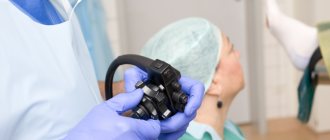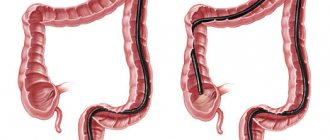What is this?
This procedure involves the use of endoscopic equipment equipped with a camera. The device is inserted through the anus, gradually moving along the entire length of the colon. The image is broadcast on the screen in real time, thanks to which the doctor can assess the condition of the walls and cavity, identify any neoplasms, obstruction, foreign body, areas of erosion or inflammation, and much more. Today, examination of the intestines without colonoscopy is practically not carried out. Only this technique is highly informative and safe.
Despite the absence of any harm to the patient's health, colonoscopy without anesthesia is performed infrequently. This is due to severe discomfort and slight pain that occurs during examination or performing medical procedures. In modern medical practice, 3 main types of anesthesia are used before this procedure:
- Colonoscopy of the intestines without anesthesia, in a dream
. In this case, sedation is used. The patient is injected with a sedative drug with a hypnotic effect, which, when activated, dulls his pain sensitivity. - Local anesthesia
. The tip of the endoscope is lubricated with an anesthetic, which eliminates discomfort after insertion of the tube. However, its action is ineffective during air injection, since it acts locally and only in the first stages of inspection. - Anesthesia sleep
. This method is used in an operating room. The anesthesiologist selects the composition and dosage of drugs, after the administration of which the patient loses consciousness. The duration of this condition exceeds the duration of endoscopy. As a rule, this method is prescribed to people with a low pain threshold and children under 12 years of age.
Colonoscopy of the intestines - is it scary?
“Blessed is he who has a bowel movement in the morning without being forced to
That’s why there is food according to the gut and all pleasures are available.”
(authorship is attributed to Alexander Sergeevich Pushkin)
Constipation and diarrhea are not the only reasons that may be an indication for this study. When and for what symptoms should a colonoscopy be done? Is it really necessary?
These and other questions are answered by Yulia Nikolaevna Kalinina, an endoscopist at Clinic Expert Kursk LLC.
- Yulia Nikolaevna, please tell us what intestinal colonoscopy is and when is it prescribed?
Colonoscopy (or fibrocolonoscopy) is an endoscopic examination of the colon and rectum using a flexible optical device, a fiberscope.
It is recommended for all patients 40 years of age and older, regardless of the presence or absence of any complaints from the gastrointestinal tract. This is primarily due to the need for early detection of colorectal cancer. In addition, the procedure is indicated for long-term constipation, frequent bowel movements for more than 2-3 weeks with the presence of any impurities in the stool (for example, blood, mucus), other intestinal complaints, as prescribed by a proctologist or gastroenterologist.
-What parts of the intestine are looked at during a colonoscopy?
These are the rectum, sigmoid colon, descending colon, transverse colon, ascending colon, and dome of the cecum. At the request of the attending physician, it is also technically possible to examine the final section of the small intestine.
- What is visible during a colonoscopy?
During the procedure, the mucous membrane of the previously listed intestinal sections is examined. Its color, relief, defects (erosions, ulcers) and neoplasms with their size, shape, pathological deposits on the intestinal wall and some other indicators are assessed.
- Is colonoscopy a painful procedure or not?
Pain may sometimes occur, but not in all patients. Those who have undergone abdominal surgery may experience pain during a colonoscopy; in women - after removal of the uterus and appendages. The presence or absence of pain is also associated with the individual characteristics of the nervous system, in particular with the severity of the pain threshold.
But while pain during this examination sometimes occurs, discomfort always occurs. Spasms and colic may occur.
- Is there an alternative to colonoscopy today?
And it exists, and existed. The only question is the diagnostic “power” of the methods: at the moment, none of them can compete in this criterion with fibrocolonoscopy, which is the “gold standard” in identifying pathology of the large intestine.
Alternative methods include irrigoscopy, irrigography, virtual CT colonoscopy, and MRI of the intestine. It should also be remembered that with them it is impossible to take tissue fragments for histological examination, which is sometimes important for deciding on the further management of the patient.
The decision about in which cases one of the alternative methods can be used instead of colonoscopy is made by the attending physician based on the clinical picture of the individual patient, as well as the presence of contraindications or restrictions to colonoscopy.
- Yulia Nikolaevna, is it true that colonoscopy can be used not only for diagnosis, but also for treatment?
Yes it is. If during examination of the mucous membrane any new growths (for example, polyps) are discovered, at certain sizes they can be removed.
- When is a colonoscopy necessary?
As I said earlier, this is age 40 years and older, long-term stool retention, discharge of pathological impurities (blood, mucus or others), the presence of pain in the intestinal projection, a referral from the attending physician.
- Some are so afraid of this procedure that they prefer a colonoscopy under anesthesia. Is this option really better for those who are afraid?
The answer to the question “Which is better: colonoscopy with or without anesthesia” depends on several points.
If the patient is sensitive to pain or falls into the category of people we talked about earlier, the procedure is best performed under anesthesia. It is mandatory when examining patients with mental disorders, as well as if initially not only diagnostics are carried out, but also therapeutic manipulations (for example, removal of polyps).
- How to properly prepare for a colonoscopy? Is a special diet necessary?
Preparation for this study is very important. If it is carried out correctly, the entire length of the intestinal mucosa will be available for inspection and the doctor will not miss any potentially dangerous changes.
Three days before the colonoscopy procedure, a person must follow a slag-free diet: salty, smoked foods, gray and bran bread are excluded. You can eat dried white bread in small quantities. It is necessary to exclude porridge.
The intestines themselves are emptied of contents in two ways: either special laxatives are taken, or an enema is performed (supplemented by taking castor oil orally).
- Is it possible to have a colonoscopy at the Expert Kursk Clinic? Do I need a doctor's referral to undergo diagnostics?
Yes, you can undergo this procedure in our clinic. At the moment, it is still performed without anesthesia (sedation); we do not remove polyps during the procedure.
A doctor's referral is not required, but is recommended. Why? On the one hand, the referring doctor can ask us additional questions that interest him. Another point: the doctor may not see the need for the procedure in a person, so it may be that it is not needed at all. Sometimes people make a diagnosis for themselves and undergo diagnostically valuable, but in some cases unnecessary, research.
For reference:
Kalinina Yulia Nikolaevna
Graduate of the Faculty of Medicine of Kursk State Medical University in 2009.
From 2009 to 2011 she completed clinical residency in the specialty “General Surgery”.
In 2011 - specialization in endoscopy.
Since 2015, he has been working as an endoscopist at Clinic Expert Kursk LLC.
Does it hurt?
Many patients do not know how a colonoscopy without anesthesia is performed and what they will experience during the examination. It is almost impossible to answer this question unambiguously. This is due to the fact that each person has an individual sensitivity threshold. For some people, this manipulation is associated with tolerable discomfort, while others experience severe pain, which makes further examination impossible without the use of painkillers. As a rule, the issue of anesthesia is discussed with the attending physician and anesthesiologist.
Signs of serious complications
Severe pain may indicate the development of severe complications, such as perforation of the intestinal wall. There are three main perforation mechanisms:
- Mechanical damage from a colonoscope.
- Barotrauma due to excess air supply.
- Direct damage when taking a biopsy or performing a polypectomy (removal of polyps).
In addition to acute pain, perforation is indicated by a number of accompanying symptoms: decreased blood pressure, rapid pulse, cold sticky sweat. Typically, symptoms of perforation appear immediately and are easily diagnosed by medical personnel. Occasionally, perforation may occur on the first day after the procedure, most often when the patient does not comply with medical recommendations.
It is important to remember that perforation is an extremely dangerous complication that requires immediate medical attention. It is fraught with the development of peritonitis and sepsis, which can quickly result in death.
The appearance of other severe disorders is indicated by heavy bleeding from the rectum, accompanied by pain in the lower abdomen. If at the same time the patient’s blood pressure drops (especially upper-systal), there is an increase in temperature, weakness - you need to urgently consult a doctor, since only a specialist will be able to provide the necessary assistance in a timely manner.
How is a colonoscopy done without anesthesia?
Refusal to use medicinal sleep does not affect the sequence of this medical procedure. The subject will first need to cleanse the intestines with an enema or laxatives. A few days before the examination, it is recommended to adhere to a diet, limit the consumption of coloring foods and certain medications (for example, activated carbon). There is no need to have breakfast on the day of the test. It is also worth removing contact lenses and dentures (if any).
Since colonoscopy is performed without anesthesia in a standard sequence, its main stages are:
- Take off your clothes and lie down on the couch (on your left side, pull your knees to your chest).
- Administration of local anesthetic (if desired).
- Lubricating the endoscope with a special oil that ensures better patency.
- Insertion of equipment that transmits images onto a monitor into the anus.
- Examination of anatomical structures, biopsy or endoscopic treatment.
- Removing the tube.
The main thing is preparation
I decided not to use pain relief, and decided to undergo the frightening diagnostic procedure only when it became completely unbearable. I chose the doctor by word of mouth. But it was still necessary to prepare for the upcoming execution...
How dangerous are polyps in the intestines? More details
False alarm
I entered the endoscopy room on my legs stiff from fear. But my fears were not justified. The doctor I chose turned out to be a true professional: during the examination I never felt pain. Except that sometimes there were unpleasant, but quite tolerable sensations.
Article on the topic
A new risk factor for heart attacks has been found. And a cure has been found
I flew out of the office like a bird. All my fears were behind me. And most importantly, they didn’t find anything serious about me! It was necessary to decide on this procedure at least for this reason.
The source of my suffering turned out to be irritable bowel syndrome, a functional disorder that occurs in some people in response to stress and is quite successfully treated.
Preparing for a colonoscopy: prohibited foods
Many foods should be avoided before a colonoscopy. This is everything that can cause fermentation, an increase in the volume of food masses in the intestines. To do this, it is necessary to completely exclude fatty meats, fried, smoked, spicy foods and pickles from the diet. You should also not consume legumes, nuts, coffee and chocolate. You will have to give up some raw vegetables (cabbage, radishes, garlic, turnips, radishes, beets) and greens (spinach and sorrel). For cereals, it is recommended to give preference to brown rice or buckwheat.
When following a diet, it is very important to minimize the amount of sugar, exclude sweets, baked goods, kvass, and carbonated drinks. You should also not eat apricots, peaches, grapes, raisins, dates and bananas. It is better to give up strong black tea, preferring green or still mineral water. In a procedure such as a colonoscopy, preparation for the examination is extremely important. Only complete cleansing of the intestines will allow for an effective examination of the mucous membrane.







